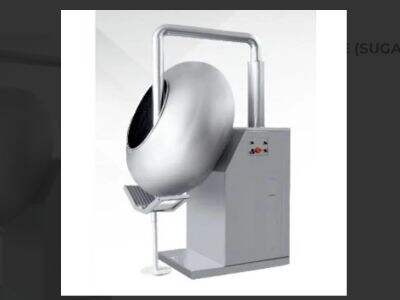Tablet coating is a specialty process, where tablets are covered with a coating. This is a critical layer that enhances the flavor of the tablets, beautifies their appearance and helps them to withstand degradation. There are tablets of various colors, sizes, and shapes, and coating is the process for protecting tablets from water, light, and air. This coating also makes the tablets a lot easier for humans to swallow and it also acts to regulate the release of the medicine from the body. Those are the three major tablet-coating, such as sugar-coated, film-coated, and enteric coated.
Understanding Pharmaceutical Tablet Coating
Sugar Coating: Sugar coating is the first method used for coating the tablets. This is an older, more traditional method. Here, the method is to coat the outside of a tablet with uncrystallized syrup. Once each layer is added, it is dried and polished, giving it a shiny and shiny appearance. The sugar coating is primarily utilized in vitamins and dietary supplements because it enhances the flavor and provides the product with a visually appealing appearance. Sugar coating is preferred by the most people as they like to take the tablets which have good flavor and look appealingly.
Film Coating — Film coating is a relatively new method of coating tablets. This method does not use a thick layer rather a clear layer made from a polymer transparent polymer is poured. This coating acts as a shield for the tablet with the help of which the moisture light and air are not able to damage the tablet. Furthermore, film coating can also mask the taste of the tablet bite or an easier experience in swallowing the tablet. This is often employed for medicine like antibiotics and pain relievers that should be delivered slowly within the body to function better.
Enteric Coating — A type of film coating. It is acid resistant — meaning it does not break down in the stomach. In contrast, this coating dissolves only in the small intestine because the atmosphere is less acidic there. This is critical, due to the fact it protects the medicinal drug from being destroyed in the stomach, which helps preserve nausea, nausea and irritation at bay. For example, aspirin or ibuprofen may be given enteric coating since they can irritate the stomach if the coating dissolves too early.
Benefits and Drawbacks of Various Types of Coating for Tablets
Sugar Coating – The primary benefit of sugar coating is that sugar-coated tablets are easier to swallow and look better overall. Everybody loves those tablets which taste well and are pleasing to the eye. This process has some drawbacks, however. The process of making sugar coating can hour, and more expensive than some methods. And you may think that adding sugar will make the tablet feel heavier and thick, also it is difficult to dissolve in the body. The sugar layer can absorb moisture from the air, resulting in sticky tablets and compromising stability.
Film Coating: Film coating also has numerous advantages. Packaging gives them great protection against moisture, light, air, etc., and significantly improves the stability and shelf-life of the tablets. That means the tablets have a longer shelf life. Apart from making tablets easier to swallow, film coating may also help improve taste. But the process of tableting with film coating is more complex and requires specialized tianfeng tablet coating equipment, so the price increases. So, the other disadvantage is delicate film-coated tablets are brittle. They can chip, peel, making the coating ineffective.
Enteric Coating: Another type of coating is enteric, and this has its own benefits. This protects the stomach from the side effects of the drug and protects against nausea, vomiting and irritation. Such a coating enables the drug to be released in a controlled manner, which enhances the clinical efficacy of the medication in the body. Enteric-coated tablet was however very potential in nature but still the process of making of enteric-coated tablets is often complex and time-consuming. Others are allergic or sensitive to the coating material, rendering it problematic for certain individuals. Furthermore, enteric-coated tablets may cost more than other types of coated pills.
Current Technology in Tablet Coating for Pharmaceuticals
Tianfeng: New Coating Technology for Pharmaceuticals- Their emphasis is on advancing technologies that better coat tablets. Nanotech-based tianfeng Tablet Coating Machine is one of the newest advancements in coating for tablets. This technology provides the ability to produce a thin, uniform, and stable film that enhances the functionality of the tablets in the body. This can minimize the required medicine and maximize its effectiveness.
Nano-coating allows even more control of the rate of release of the medication, allowing manufacturers to remove the need for extra substances called additives or excipients. Media can use this technology to shrink the size of tablets that are also easier to swallow and take. tianfeng Tablet Packing Machine technology is safe and environmentally friendly. It offers a unique customization so it can be fitted for just about any type of medication.
Quality Tablet Coating: Best Practices Lab pad
However, it is important to understand some standards and also procedures in a direction that enhances the quality of Tablet Coating. To ensure effective and safe tablet coating, Tianfeng has proposed a few best practices:
With good raw materials, you must work with High Standard Ingredients. The quality of tablets can be impacted to a large extent by the purity, stability, and compatibility of these materials.
Conditions 2: Comply with environmental and safety regulations: Tablet coating can sometimes involve materials that can be hazardous. These substances can severely contaminate; hence it is important to manage these substances and dispose of them wisely and attentively.
Purchase high-end hardware: The coating procedure requires very precise control over temperature, humidity, and various other variables. It is essential to maintain and calibrate the equipment properly for consistency and uniformity.
Adhere to Recognized Procedures and Guidelines: The process of coating includes fundamental steps that need to be carried out in a specific sequence and under particular conditions. If they make any mistake then they lose the quality and usability of the final product.
In conclusion, the tablet coating is an essential part of the tablet core since it influences the performance, safety and usability of the medication. Different properties of the drug, such as its release mechanism and another subsequent target of action, will determine the coating method. Tianfeng nano-coating technology provide a more practical route which make tablets function better with less environment pollution as well. Tablet coating is a critical process that requires adherence to industry best practices in order to satisfy the highest tablet quality and safety standards.
 EN
EN
 AR
AR
 BG
BG
 HR
HR
 CS
CS
 DA
DA
 NL
NL
 FI
FI
 FR
FR
 DE
DE
 EL
EL
 IT
IT
 JA
JA
 KO
KO
 NO
NO
 PL
PL
 PT
PT
 RO
RO
 RU
RU
 ES
ES
 SV
SV
 TL
TL
 ID
ID
 UK
UK
 VI
VI
 TH
TH
 TR
TR
 MS
MS
 KA
KA
 BN
BN
 LO
LO
 LA
LA
 MN
MN
 MY
MY
 UZ
UZ
 KY
KY



